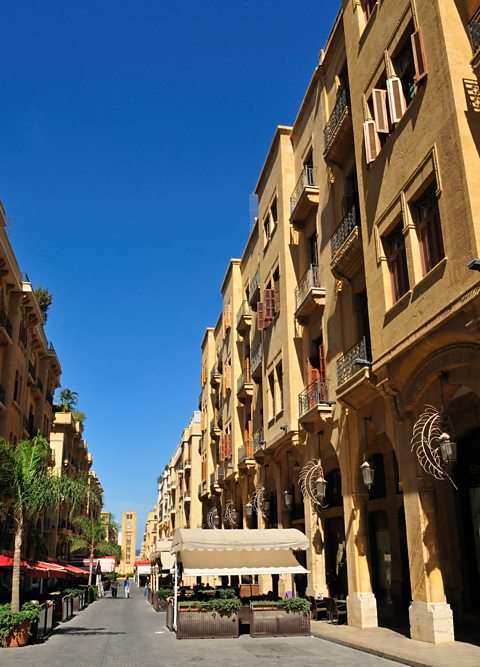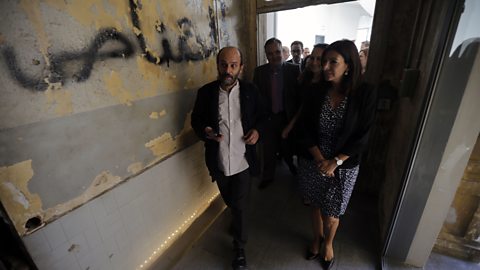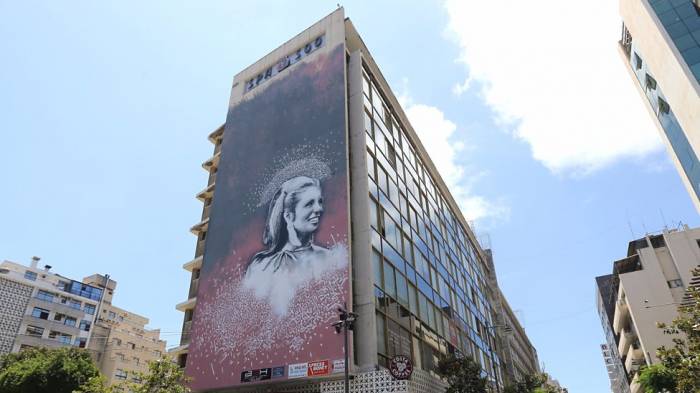Despite coming to an end in 1990, the devastating effects of the Lebanese civil war are still starkly apparent in parts of Beirut.
What of the artistic responses to the conflict?
In 2017, Cuban-American artist Jorge Rodriguez-Gerada used a shrapnel-pocked building as a canvas for a huge piece of graffiti. The work, depicting a child playing with a piece of computer hardware, was commissioned by the Beirut Digital District, a project which is attempting to, in part, heal the wounds of that conflict. (Critics have argued, however, that the BDD is more concerned about gentrifying impoverished neighbourhoods than anything else.)
While the Foreign Office advises against travel to southern suburbs of Beirut, Beirut wasn't visually what Janina Ramirez expected.
She says: "The ancient market, or souk, is the historic heart of the city, but there’s not much trace of its past left. And in some areas of the city, it's hard to see that Lebanon ever suffered a civil war. In the 25 years since the end of the war, everywhere you look has been rebuilt and repurposed.

The modern-looking old town in Beirut | © imageBROKER / Alamy
"For many Beirutis the rebuilding went too far. Hardly a trace of the war remains, and you can’t help noticing there’re no memorials. As people say here, it’s as if amnesty has turned to amnesia."
There are some people though, like architect Youssef Haidar, who are actively trying to remember.
Beit Beirut – House of Beirut – was an old residential block that became a notorious sniper’s den on the war’s frontline. Youssef Haidar was commissioned to turn this house into a memorial.

The wartime use of Beit Beirut remains clear to see | © Patrick Baz / AFP / Getty
Youssef tells Janina about the philosophy behind the reconstruction: "This building is a living being and working with it is a healing process. We work like surgeons, we heal the wounds, and if some part is missing, we replace it with a prosthetic element."
Why preserve a place responsible for the deaths of so many innocent people?
It's only at close quarters that you can see how a functional object could become something else. After showing Janina the interior of the building, Youssef takes her outside. He says: "All you see in fact is a door. Generally you are afraid of a tank or a soldier, you are never afraid of a door or a house. But the house in this case became a weapon or a killing machine."
Janina is incredibly moved by see Beit Beirut at first hand. She says: "It’s a scarred building, but what I think Youssef has done so amazingly is he’s not shied away from that, he’s not sugared the pill. It’s unflinching, it’s disturbing, it's moving, but it’s actually really beautiful."

Youssef Haidar shows Paris mayor Anne Hidalgo around Beit Beirut. The French capital provides project management help | © Joseph Eid / AFP Photo / Getty
But its not just in retrospect that Lebanese artists engaged with the topic of war - they also created work about the conflict while it was still going on.
Abdel Hamid Baalbaki, a Shia Muslim who witnessed the fighting, created arguably the most famous image of the conflict, The War Mural, in 1976.
Baalbaki died in 2013, but Alastair Sooke finds out more about the story of this painting from Baalbaki's friend, gallery owner Saleh Barakat.
Barakat says: "He had to leave Beirut because of the bombings. On the way to the south he saw the village of Damur being burned, the massacre. That affected him deeply. He saw everyone fighting as monsters. The ones suffering were the poor people. I can see here there’s a figure actually aflame, burning.
"But in his mind, it was the whole city of Beirut that was being destroyed. It feels he’s going for a timeless, mythical effect. These strange, gloomy creatures of the night - owls, bats. He came up with all these monsters, the people behind the wars, the people that financed the wars."
Despite the peace, Beirut is still largely split demographically between Muslim West and Christian East. But contemporary Lebanese artists like Yazan Halwani are working to create art which resonates across divisions.

Lebanese diva Sabah appears on a side wall of a building in Beirut's Hamra district | © Joseph Eid / AFP Photo / Getty
Alastair went to meet him in Hamra, a traditionally Sunni Muslim area in West Beirut. It was previously known for its vibrant cultural scene but became more commercial following the end of the civil war.
Yazan has brought art back to the area with a massive mural of legendary singer Sabah, a figure popular with all. "She came from a a Christian community," Yazan says, "but she was loved everywhere. She is one of the few figures able to transcend the sectarian cultural barriers.
"What I do in the public sphere is to create artworks which create some sense of unity, or searches for a national identity. I think the soul of Beirut is in this internal quest for finding the soul of Beirut. Lebanon has always been in flux, you cannot peg any identity on it because it’s in transit."
BBC
















































